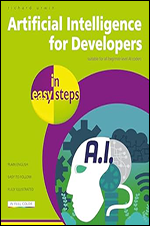Intelligent Sensor Networks: The Integration of Sensor Networks, Signal Processing and Machine Learning
- 13h 47m
- Fei Hu, Qi Hao (eds)
- CRC Press
- 2013
Although governments worldwide have invested significantly in intelligent sensor network research and applications, few books cover intelligent sensor networks from a machine learning and signal processing perspective. Filling this void, Intelligent Sensor Networks: The Integration of Sensor Networks, Signal Processing and Machine Learning focuses on the close integration of sensing, networking, and smart signal processing via machine learning.
Based on the world-class research of award-winning authors, the book provides a firm grounding in the fundamentals of intelligent sensor networks, including compressive sensing and sampling, distributed signal processing, and intelligent signal learning. Presenting recent research results of world-renowned sensing experts, the book is organized into three parts:
- Machine Learning—describes the application of machine learning and other AI principles in sensor network intelligence—covering smart sensor/transducer architecture and data representation for intelligent sensors
- Signal Processing—considers the optimization of sensor network performance based on digital signal processing techniques—including cross-layer integration of routing and application-specific signal processing as well as on-board image processing in wireless multimedia sensor networks for intelligent transportation systems
- Networking—focuses on network protocol design in order to achieve an intelligent sensor networking—covering energy-efficient opportunistic routing protocols for sensor networking and multi-agent-driven wireless sensor cooperation
Maintaining a focus on "intelligent" designs, the book details signal processing principles in sensor networks. It elaborates on critical platforms for intelligent sensor networks and illustrates key applications—including target tracking, object identification, and structural health monitoring. It also includes a paradigm for validating the extent of spatiotemporal associations among data sources to enhance data cleaning in sensor networks, a sensor stream reduction application, and also considers the use of Kalman filters for attack detection in a water system sensor network that consists of water level sensors and velocity sensors.
About the Editors
Dr. Fei Hu is currently an associate professor in the Department of Electrical and Computer Engineering at the University of Alabama (main campus), Tuscaloosa, Alabama. He received his PhDs from Tongji University (Shanghai, China) in the field of signal processing (in 1999) and from Clarkson University (New York) in the field of electrical and computer engineering (in 2002). He has published over 150 journal/conference papers and book chapters. Dr. Hu’s research has been supported by U.S. NSF, Cisco, Sprint, and other sources. His research expertise can be summarized as 3S—security, signals, and sensors: (1) security, which includes cyberphysical system security and medical security issues; (2) signals, which refers to intelligent signal processing, that is, using machine learning algorithms to process sensing signals; and (3) sensors, which includes wireless sensor network design issues.
Dr. Qi Hao is currently an assistant professor in the Department of Electrical and Computer Engineering at The University of Alabama, Tuscaloosa, Alabama. He received his PhD from Duke University, Durham, North Carolina, in 2006, and his BE and ME from Shanghai Jiao Tong University, China, in 1994 and 1997, respectively, all in electrical engineering. His postdoctoral training in the Center for Visualization and Virtual Environment at The University of Kentucky was focused on 3Dcomputer vision for human tracking and identification. His current research interests include smart sensors, intelligent wireless sensor networks, and distributed information processing. His research has been supported by U.S. NSF and other sources.
In this Book
-
Machine Learning Basics
-
Modeling Unreliable Data and Sensors—Using Event Log Performance and F-Measure Attribute Selection
-
Intelligent Sensor Interfaces and Data Format
-
Smart Wireless Sensor Nodes for Structural Health Monitoring
-
Knowledge Representation and Reasoning for the Design of Resilient Sensor Networks
-
Intelligent Sensor-to-Mission Assignment
-
Prediction-Based Data Collection in Wireless Sensor Networks
-
Neuro-Disorder Patient Monitoring via Gait Sensor Networks—Toward an Intelligent, Context-Oriented Signal Processing
-
Cognitive Wireless Sensor Networks
-
Routing for Signal Processing
-
On-Board Image Processing in Wireless Multimedia Sensor Networks—A Parking Space Monitoring Solution for Intelligent Transportation Systems
-
Signal Processing for Sensing and Monitoring of Civil Infrastructure Systems
-
Data Cleaning in Low-Powered Wireless Sensor Networks
-
Sensor Stream Reduction
-
Compressive Sensing and Its Application in Wireless Sensor Networks
-
Compressive Sensing for Wireless Sensor Networks
-
Framework for Detecting Attacks on Sensors of Water Systems
-
Reliable and Energy-Efficient Networking Protocol Design in Wireless Sensor Networks
-
Agent-Driven Wireless Sensors Cooperation for Limited Resources Allocation
-
Event Detection in Wireless Sensor Networks
-
Dynamic Coverage Problems in Sensor Networks
-
Self-Organizing Distributed State Estimators
-
Low-Power Solutions for Wireless Passive Sensor Network Node Processor Architecture
-
Fusion of Pre/Post-RFID Correction Techniques to Reduce Anomalies
-
Radio Frequency Identification Systems and Sensor Integration for Telemedicine
-
A New Generation of Intrusion Detection Networks




